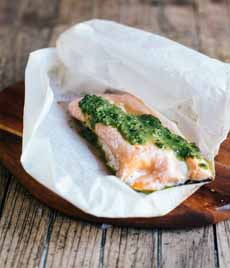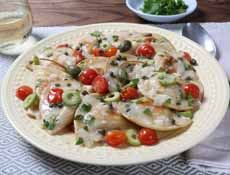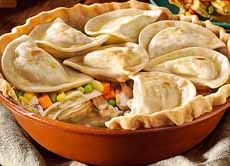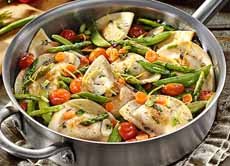TOP PICK OF THE WEEK: LoveTheWild & More Finds From The Freezer
|
This week’s Top Pick is Love The Wild frozen fish, with runner-up Orca Bay Seafood and an honorable mention to Mrs. T’s Pierogies.
1. LOVE THE WILD FROZEN FISH ENTRÉES Only one in five Americans meet the USDA recommendation for fish intake*, a vital high protein dietary component that’s high in protein and healthy fats. Home cooks and restaurants have been finding more ways to nudge it into our diet, From fish tacos to smoked salmon pizza (white sauce, salmon caviar, yum!) to sushi rolls. We try to eat fish several nights a week. But on frequent occasions, we lack the energy to stand in line at the fish counter, or sit down at the sushi bar. And sometimes the kitchen is too much of a mess to bring out more pots and pans. Were we happy to discover LoveTheWild, a line of sustainably-sourced fish entrées that take no more energy than pre-heating the oven. It’s fool-proof, and there’s no messy pan: The parchment paper holds the fish and the sauce (from the seasoned butter) tight. Delicious seafood from traceable sources that consumers could trust.The brand is sold at major retailers across the U.S., including Whole Foods Markets, Wegmans, Sprouts, and Mom’s. The line currently includes: Here’s a store locator. Also noteworthy: this infographic on aquaculture, fish farming and photos of the fish farms. Discover more at LoveTheWild.com. Like many people we know, we try to cook fresh food daily. And we try to eat a mostly pescatarian diet. But on those days of sheer exhaustion—no will to battle lines at the fish market—we turn to the freezer. Orca Bay Seafoods sells a dozen different frozen fish fillets, mostly wild-caught (the swai† and tilapia are farmed). The company was launched in 1985 by seafood executives. At the time, the frozen fish options were not as good as they knew there could be. They established the company to provide higher quality, all natural frozen seafood. There are choices from mild to meaty: |
[3] Orca Bay cod fillets in a noodle bowl with veggies (photo courtesy Dana Sandonato | Killing Thyme). |
|
|
How can you resist a five-ounce serving of meaty cod, with just 90 calories, 1 g fat, 110mg sodium and more than 30% of your DV of protein (17g). There are recipes on the website, and many bloggers have embraced the brand. Check out this Orca Bay Cod Reuben Sandwich. There’s a store locator on the website, and e-tail options including Orca Direct. Discover more at OrcaBaySeafoods.com. *The USDA’s Dietary Guidelines for Americans recommends two eight-ounce servings of seafood weekly,to get at least 1,750 milligrams of two omega-3s, EPA (eicosapentaenoic acid) and DHA (docosahexaenoic acid). †Swai, along with related species basa and tra, belong to what’s called the Pangasius family of fish. They are native to the rivers of Southeast Asia, where they are heavily cultivated for food. Pangasius fish are similar in character to catfish: sweet, mild white flesh. The breed has been introduced into other river basins around the world as a food source. Since price is partly based on demand, these “new” fish is a bargain—often just $3.99 a pound. Orca Bay Seafood’s swai is farmed in the U.S. |
||
|
|
MRS. T’s PIEROGIES Pierogies‡, also called as varenyky, are semicircle filled dumplings that are a popular in Central and Eastern European cuisines. They are served as appetizer, main courses and, even as dessert. Pierogies are variously filled with cabbage, cheese (farmer’s cheese or quark), fried onions, ground meat, mashed potatoes, mushrooms, sauerkraut and spinach. Dessert varieties are filled with sweetened cheese, fresh fruit or jam. The original condiments for pierogies were sour cream and butter. By the end of the 20th century, queso (cheese sauce), buffalo wing sauce and others had been added to the list. Mrs. T’s has turned pierogies into scores of delicious recipes, from Greektown Pierogi Salad to Pierogi Scampi. For National Pierogi Day, October 8th, there’s new set of recipes by Iron Chef America star, Jose Garces. Chef Garces created four restaurant-inspired recipes featuring Mrs. T’s Pierogies that you can enjoy as a main course: |
|
|
Mrs. T’s Pierogies are certified kosher (dairy) by the Orthodox Union with the exception of Broccoli & Aged Cheddar, which is certified by Kosher Overseers. Discover more at MrsTsPierogies.com. THE HISTORY OF PIEROGIES Pieróg is a generic Polish term for filled dumplings. One belief is that pierogis—filled pasta—came from China through Italy with Marco Polo’s return, at the end of the 13th century. He brought back the Chinese concept of the filled pasta (think Chinese filled wontons and dumplings) that inspired Italy’s agnolotti, ravioli, tortellini and other stuffed pasta varieties. While boiled noodles (ribbon pasta) were known in the Middle East since the fifth century C.E., and made their way to Italy during the Arab invasions of the 8th century, stuffed pasta pillows were not known before Marco Polo. Another version of the story contends that pierogi were brought to back to Poland from Russia by Saint Hyacinth of Poland, or by the Tartars—also in the the 13th century (here’s the history of pasta). However and whenever, pierogi became a culinary staple Belarusse, Latvia, Lithuania, Poland, Slovakia, the Ukraine, Romania and Russia. Whey were garnished with bits of bacon, fried onions and/or mushrooms. Dessert varieties were topped with apple sauce, jam, or preserves. It took a while for pierogies to cross the pond. The introduction of the pierogi to the U.S. occurred at the onset of the Great Depression in the late 1920s. The first-known documented sale of pierogi occurred in May 1928 at the Marton House Tavern in Cleveland, when proprietor Andrew Marton served them to unemployed steel mill workers [source]. Mrs. T’s was founded in 1952. The company currently makes some 14 varieties of pierogies and produces more than 500 million pierogies annually. ‡The word pierogi in Polish, Russian and other central European languages is plural. However, in English it is typically used as the singular form, with “pierogies” used as the plural. |
||










